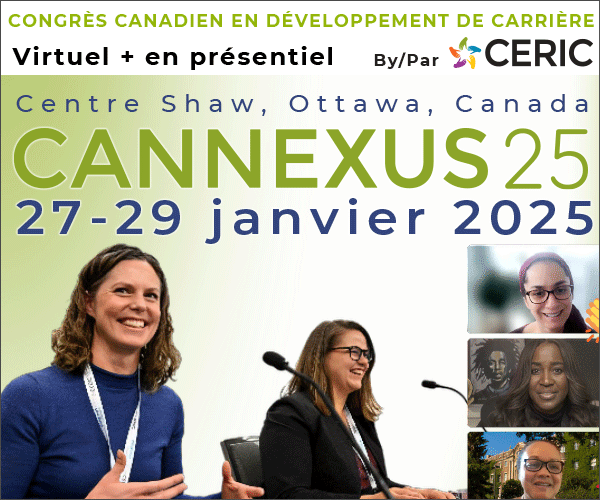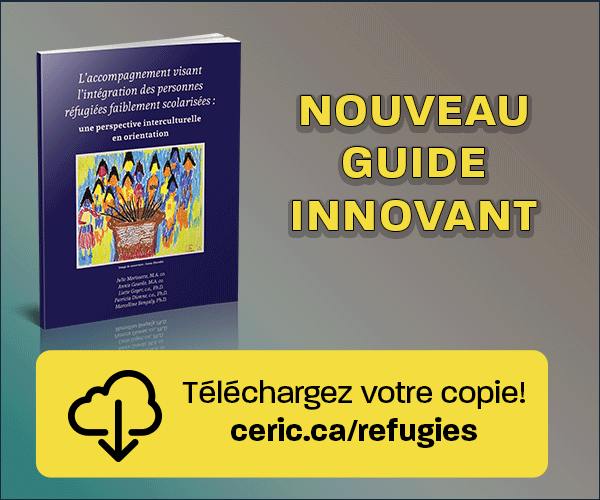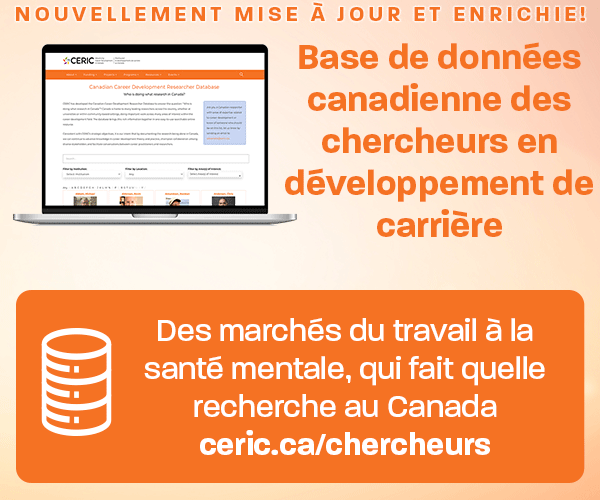L'effet des variables sociales sur les aspirations professionnelles des adultes autochtones au Nouveau-Brunswick
Mots-clés :
peuples autochtones du canada, aspirations professionnellesRésumé
Un sondage effectué récemment auprès des Peuples Autochtones du Nouveau-Brunswick par l’organisation Joint Economic Development Initiative Inc. (JEDI) a recueilli des données à l’égard des facteurs sociaux qui influencent les aspirations de carrière. Ces variables sociales incluent : le genre, l’état matrimonial, le niveau d’éducation, la dépendance envers l’assistance sociale et la mobilité. Ces variables ont été analysées afin d’identifier des différences significatives à l’égard des aspirations de carrière mesurées par O*Net Job Zones. Un ensemble final de données de 202 répondants a été utilisé pour l’analyse des données. Les résultats s’alignent avec la théorie de Gottfredson du compromis et de la circonscription puisque la préparation a démontré
un effet significatif envers les aspirations de carrière. Certains facteurs externes à ce cadre, incluant le statut matrimonial, le genre, la dépendance envers l’assistance sociale et la mobilité, étaient également analysés. Les résultats ont démontré que les femmes qui ont participé possèdent de aspirations de arrières plus élevées que celles des hommes, et que les participants moins mobiles avaient des aspirations de carrière plus élevées. Des implications à égard des théories du développement de de carrière des autochtones, les recherches futures et l’orientation professionnelle sont discutées.
Références
Alfred, T. G. (2009). Colonialism and state dependency. Journal of Aboriginal Health, 5(2), 42-60. Andersen, S. H. (2015). Serving time or serving the community? Exploiting a policy reform to assess the causal effects of community service on income, social benefit dependency, and recidivism. Journal of Quantitative Criminology, 31, 537-563. doi:10.1007/s10940-014-9237-2
Arkwright-Alivisatos, D. (1997). The chosen path: Career decisions of aboriginal adult learners (Master’s thesis). Available from ProQuest Dissertations & Theses. (UMI
No. 304421857)
Benjamin, A., Domene, J., & Landine, K. (2014). Constructing the future in liminal spaces between adolescence and adulthood: Responsibilities, careers, and social contexts. Canadian Journal of Career Development, 13(1), 47-58. Retrieved from http://cjcdonline.ca/archives/
Bibby, R. W. (2010). Alberta’s emerging millenials: A national survey of Alberta teens and other teens. Lethbridge, AB: Project Canada Books. Retrieved from http://www.reginaldbibby.com/images/Alberta_s_Emerging_Millennials_MASTER.pdf
Brosseau, D., Domene, J. F., & Dutka, T. (2010). The importance of partner involvement in determining career decision making difficulties. Canadian Journal of Career Development, 9(2), 35-41. Retrieved from http://cjcdonline.ca/archives/
Bruce, D., Marlin, A., & Doucette, M. B. (2010). The Atlantic aboriginal post-secondary labour force. Retrieved from the Atlantic Policy Congress of First Nations Chiefs
Castellano, M.B. (2004). Ethics of Aboriginal research. Journal of Aboriginal Health, 1(1), 98-114.
Cochran, D. B., Wang, E. W., Stevenson, S. J., Johnson, L. E., & Crews, C. (2011). Adolescent occupational aspirations: Test of Gottfredson’s theory of circumscription and compromise. The Career Development Quarterly, 59, 412-427. doi:10.1002/j.2161-0045.2011.tb00968.x
Craven, R. G., Tucker, A., Munns, G., Hinkley, J., Marsh, H. W., & Simpson, K. (2005). Indigenous students’ aspirations: Dreams, perceptions and realities. Canberra: Department of Education. Science and Training, Commonwealth of Australia.
Delisle, F. & Shearmur, R. (2010). Where does all the talent flow? Migration of young graduates and nongraduates, Canada 1996- 2001. The Canadian Geographer,
, 305-323. doi:10.1111/j.1541-0064.2009.00276.x
Department of Post-Secondary Education, Training, and Labour (2013). Profile of the New Brunswick Labour Force. Retrieved from New Brunswick Department of Post-secondary Education, Training and Labour website: http://www2.gnb.ca/content/dam/gnb/ Departments/petl-epft/PDF/Emp/Profile-NBLabourForce.pdf
Domene, J., Nee, J., Cavanaugh, A., McLelland, S., Stewart, B., Stephenson, M., Kauffman, B., Young, R. (2012). Young adult couples transitioning to work: The intersection of career and relationship. Journal of Vocational Behavior, 81, 17-25. doi:10.1016/j.jvb.2012.03.005
Dragonfly Solutions (2011). Assessment of career planning and guidance services for New Brunswick’s First Nations students. Fredericton, NB: First Nations Education Initiative Inc.
Ermine, W., Sinclair, R., Jeffery, B. (2004). The ethics of research involving indigenous peoples. Saskatoon, SK: Indigenous Peoples’ Health Research Centre.
Field, A. (2013). Discovering statistics using IBM SPSS statistics (4th ed.). Thousand Oaks, CA: Sage Publications.
Fong, F. & Gulati, S. (2013). Employment and education among Aboriginal Peoples: A new perspective from the 2011 National Household Survey (Special Report, TD
Economics). Retrieved from TD Economics website: http://www.td.com/ document/PDF/economics/ special/EmploymentAndEducationAmongAboriginalPeoples.pdf
Gottfredson, L. S. (1981). Circumscription and compromise: A developmental theory of occupational aspirations. Journal of Counseling Psychology Monograph, 28, 545-579. doi:10.1037/0022-0167.28.6.545
Gottfredson, L. S. (1996). Gottfredson’s theory of circumscription and compromise. In D. Brown & L. Brooks (Eds.), Career choice and development (pp. 179-232). San Francisco, CA: Jossey-Bass.
Hoffman, L. L., Jackson, A. P., & Smith, S. A. (2005). Career barriers among Native American students living on reservations. Journal of Career Development 32(1), 31-45. doi: 10.1177/0894845305277038
Howard, K., Carlstrom, A, Katz, A., Chew, A., Ray, G., Laine, L., & Caulum, D. (2011). Career aspirations of youth: Untangling race/ethnicity, SES, and gender. Journal of Vocational Behavior, 79, 98-109. doi:10.1016/j. jvb.2010.12.002
Hwang, M., Kim, J., Ryu, J. Y., & Heppner, M. J. (2006). The circumscription process of career aspirations in South Korean adolescents. Asia Pacific Education Review, 7, 133-143. doi:10.1007/bf03031537
Jackson, A. P. & Smith, S. A. (2001). Postsecondary transitions among Navajo Indians. Journal of American Indian Education, 40(2), 28-47.
Johnson, L. (1995). A Multidimensional Analysis of the Vocational Aspirations of College Students. Measurement and Evaluation in Counseling and Development, 28(1), 25-44.
Junk, K. E. & Armstrong, P. I. (2010). Stability of career aspirations: A longitudinal test of Gottfredson’s theory. Journal of Career Development, 37, 579-598. doi:10.1177/0894845309350921
Juntunen, C. L., Barraclough, D. J., Broneck, C. L., Seibel, G. A., Winrow, S. A., & Morin, P. M. (2001). American Indian perspectives on the career journey. Journal of Counseling Psychology, 48, 274-285. doi:10.1037/0022-0167.48.3.274
Kelly-Scott, K. & Smith, K. (2011). Aboriginal peoples: Fact sheet for Canada. Retrieved from Statistics Canada website: http://www.statcan.gc.ca/pub/89-656-x/89-656-x2015001-eng.pdf
Koul, R., Lerdpornkulrat, T., & Chantara, S. (2011). Relationship between career aspirations and measures of motivation toward biology and physics, and the Influence of Gender. Journal of Science Education and Technology, 20, 761-770. doi:10.1007/s10956-010-9269-9
Kregel, J. (2009). Work incentives and assistance: Assisting beneficiaries to obtain employment and reduce dependence on SSA benefits. Journal of Vocational Rehabilitation, 31, 1-9. doi:10.3233/JVR-2009-0466
Levine, J. D. (2003). Use of the O*NET Descriptors in Numerical Occupational Classification: An Exploratory Study (Doctoral dissertation, North Carolina State University). Retrieved from https://repository.lib.ncsu.edu/handle/1840.16/5102
McCormick, R.M. & Amundson, N.E. (1997). A career-life planning model for First Nations people. Journal of Employment Counseling, 34(4), 171-179. doi:10.1002/j.2161- 1920.1997.tb00467.x
McCormick, R. & Honore, M. H. (1995). Counselling First Nations clients on career issues: Implications for the school counsellor. Guidance & Counseling, 10(2), 27-31.
McCormick, R.M., Neumann, H., Amundson, N.E., & McLean, H.B. (1999). First Nations career/life planning model: Guidelines for practitioners. Journal of Employment
Counseling, 36(4), 167-176. doi:10.1002/j.2161-1920.1999.tb01019.x
Merrill, S., Bruce, D., & Marlin, A. (2010). Considerations for successful transitions between postsecondary education and labour market for aboriginal youth in Canada: Final report. Sackville, NB: Rural and Small Town Programme, Mount Allison University.
Mitchell, P. (2014). Save up to marry? Or marry to save up? eReview: Latest Developments in Family Friendly Research, 14 (1), 1-3. Retrieved from http://www.imfcanada.org/issues/savemarry-or-marry-save
Neumann, H., McCormick, R.M., Amundson, N.E., McLean, H.B. (2000). Career counselling First Nations youth: Applying the First Nations career-life planning model. Canadian Journal of Counselling, 34(3), 172-185.
Ng, T. W. H., Eby, L. T., Sorensen, K. L., & Feldman, D. C. (2005). Predictors of objective and subjective career success: A meta-analysis. Personnel Psychology, 58(2), 367–409. doi:10.1016/j.jvb.2012.06.003
Offet-Gartner, K. (2008). Sharing the story: Education as the key to unlocking the door of career possibilities with First Nations women (Doctoral dissertation, University of Calgary). Available from ProQuest Dissertation & Theses Global database. (UMI No. 304693647)
Perry, J., Przybysz, J., & Al-Sheikh, M. (2009). Reconsidering the “aspiration-expectation gap” and assumed gender differences among urban youth. Journal of Vocational Behavior, 74, 349-354. doi:10.1016/j.jvb.2009.02.006
Rojewski, J. W. (2005). Occupational aspirations: Constructs, meanings, and application. In S.D. Brown and R.W. Lent (Eds.), Career development and counseling: Putting theory and research to work (pp.131-154). Hoboken, NJ: John Wiley.
Rojewski, J. W. & Lee, I. H. (2009). Development of occupational aspiration prestige: A piecewise latent growth model of selected influences. Journal of Vocational Behaviour, 75, 82-90. doi:10.1016/j.jvb.2009.03.006
Roness, L. A. & Collier, M. (2010). Assessing the effectiveness of labour force participation strategies. Retrieved from Atlantic Policy Congress of First Nations Chiefs website: http://www.apcfnc.ca/images/uploads/FinalReport-AssessingtheEffectivenessofLabourForceParticipationStrategies.pdf
Schoon, I. & Polek, E. (2011). Teenage career aspirations and adult career attainment: The role of gender, social background and general cognitive ability. International
Journal of Behavioral Development, 35, 210-217. doi:10.1177/016502541139818 3
Spowart, J. K. & Marshall, E. A. (2015). Relational and cultural impacts on the work life of young Indigenous men. Canadian Journal of Counselling and Psychotherapy, 49, 214-231.
Tucker, J. & Fushell, M. (2013). Graduate programs in education: Impact on teachers’ careers. Canadian Journal of Educational Administration and Policy, 148, 1-26. Retrieved from https://www.umanitoba.ca/publications/cjeap/pdf_files/tucker_fushell.pdf
Turcotte, M., & Weeks, J. (2014). The migration of infrastructure tradespersons. Retrieved from Statistics Canada website: http://www.statcan.gc.ca/pub/75-006-x/2014001/article/14011-eng.htm
Watt, H. M., Shapka, J. D., Morris, Z. A., Durik, A. M., Keating, D. P., & Eccles, J. S. (2012). Gendered motivational processes affecting high school mathematics participation, education aspirations, and career plans: A comparison of samples from Australia, Canada, and the United States. Developmental Psychology, 48, 1594-1611. doi: 10.1037/a0027838
White, J., Maxim, P., & Gyimah, S. O. (2003). Labour force activity of women in Canada: A comparative analysis of Aboriginal and non-Aboriginal women. The Canadian Review of Sociology and Anthropology, 40, 391-415. doi:10.1111/j.1755-618x.2003.tb00254.x
Ying, L. & Michalopoulos, C. (2001). SSP Plus at 36 Months: Effects of Adding Employment Services to Financial Work Incentives. Ottawa, ON: Social Research and Demonstration Corporation.

Téléchargements
Publié-e
Comment citer
Numéro
Rubrique
Licence

Cette œuvre est sous licence Creative Commons Attribution - Pas d'Utilisation Commerciale - Pas de Modification 4.0 International.











